
The Lockheed Constellation ("Connie") is a propeller-driven, four-engined airliner built by Lockheed Corporation starting in 1943. The Constellation series was the first pressurized-cabin civil airliner series to go into widespread use. Its pressurized cabin enabled commercial passengers to fly well above most bad weather for the first time, thus significantly improving the general safety and ease of air travel.

The Wright R-3350 Duplex-Cyclone is a twin-row, supercharged, air-cooled, radial aircraft engine with 18 cylinders displacing nearly 55 L. Power ranged from 2,200 to over 3,700 hp, depending on the model. Developed before World War II, the R-3350's design required a long time to mature before finally being used to power the Boeing B-29 Superfortress. After the war, the engine had matured sufficiently to become a major civilian airliner design, notably in its turbo-compound forms, and was used in the Lockheed L-1049 Super Constellation airliners into the 1990s. The engine is commonly used on Hawker Sea Fury and Grumman F8F Bearcat Unlimited Class Racers at the Reno Air Races. Its main rival was the 71.5 L, 4,300 hp (3,200 kW) Pratt & Whitney R-4360 Wasp Major, first run some seven years after the Duplex-Cyclone's beginnings.
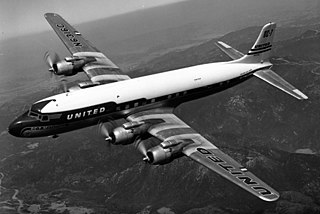
The Douglas DC-7 is an American transport aircraft built by the Douglas Aircraft Company from 1953 to 1958. A derivative of the DC-6, it was the last major piston engine-powered transport made by Douglas, being developed shortly after the earliest jet airliner—the de Havilland Comet—entered service and only a few years before the jet-powered Douglas DC-8 first flew. Unlike other aircraft in Douglas's line of propeller-driven aircraft, no examples remain in service in the present day, as compared to the far more successful DC-3 and DC-6.

The Boeing C-97 Stratofreighter was a long-range heavy military cargo aircraft developed from the B-29 and B-50 bombers. Design work began in 1942, the first of three prototype XC-97s flew on 9 November 1944, and the first of six service-test YC-97s flew on 11 March 1947. All nine were based on the 24ST alloy structure and Wright R-3350 engines of the B-29, but with a larger-diameter fuselage upper lobe and they had the B-29 vertical tail with the gunner's position blanked off. The first of three heavily revised YC-97A incorporating the re-engineered wing, taller vertical tail and larger Pratt and Whitney R-4360 engines of the B-50 bomber, flew on 28 January 1948 and was the basis of the subsequent sole YC-97B, all production C-97s, KC-97s and civilian Stratocruiser aircraft. Between 1944 and 1958, 888 C-97s in several versions were built, 811 being KC-97 tankers. C-97s served in the Berlin Airlift, the Korean War, and the Vietnam War. Some aircraft served as flying command posts for the Strategic Air Command, while others were modified for use in Aerospace Rescue and Recovery Squadrons (ARRS).

The Lockheed EC-121 Warning Star was an American airborne early warning and control radar surveillance aircraft operational in the 1950s in both the United States Navy (USN) and United States Air Force (USAF).
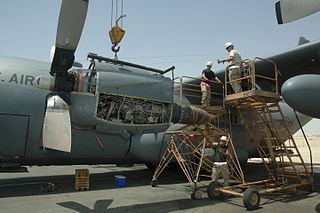
The Allison T56 is an American single-shaft, modular design military turboprop with a 14-stage axial flow compressor driven by a four-stage turbine. It was originally developed by the Allison Engine Company for the Lockheed C-130 Hercules transport entering production in 1954. It has been a Rolls-Royce product since 1995 when Allison was acquired by Rolls-Royce. The commercial version is designated 501-D. Over 18,000 engines have been produced since 1954, logging over 200 million flying hours.

The Lockheed Altair was a single-engined sport aircraft of the 1930s. It was a development of the Lockheed Sirius with a retractable undercarriage, and was the first Lockheed aircraft and one of the first aircraft designs with a fully retractable undercarriage.
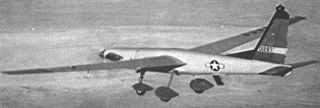
The Ling-Temco-Vought XQM-93 was a remotely piloted aircraft developed in the United States in the late 1960s and early 1970s for use as a communications relay in the Vietnam War. A prototype flew in 1970, but the program was abandoned without producing a service-ready aircraft.

The Pratt & Whitney T34 was an American axial flow turboprop engine designed and built by Pratt & Whitney. Its only major application was on the Douglas C-133 Cargomaster.
The Lockheed Model 44 Excalibur was a proposed American airliner designed by Lockheed. The Model 44 was the first four-engined design from the company, a low-wing monoplane with a retractable tricycle landing gear. Originally fitted with twin fins, the design ended up with three fins. It was to be powered by four 1200 hp Pratt & Whitney Twin Wasp radial engines. Pan American Airways was close to ordering the Excalibur when Lockheed abandoned the project to devote its resources into developing the Model 49 Constellation that had been ordered by Trans World Airlines.
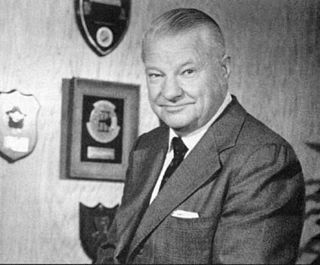
Clarence Leonard "Kelly" Johnson was an American aeronautical and systems engineer. He is recognized for his contributions to a series of important aircraft designs, most notably the Lockheed U-2 and SR-71 Blackbird. Besides the first production aircraft to exceed Mach 3, he also produced the first fighter capable of Mach 2, the United States' first operational jet fighter, as well as the first fighter to exceed 400 mph, and many other contributions to various aircraft. As a member and first team leader of the Lockheed Skunk Works, Johnson worked for more than four decades and is said to have been an "organizing genius". He played a leading role in the design of over forty aircraft, including several honored with the prestigious Collier Trophy, acquiring a reputation as one of the most talented and prolific aircraft design engineers in the history of aviation. In 2003, as part of its commemoration of the 100th anniversary of the Wright Brothers' flight, Aviation Week & Space Technology ranked Johnson eighth on its list of the top 100 "most important, most interesting, and most influential people" in the first century of aerospace. Hall Hibbard, Johnson's Lockheed boss, referring to Johnson's Swedish ancestry, once remarked to Ben Rich: "That damned Swede can actually see air."

The Lockheed C-69 Constellation was a four-engined, propeller-driven military transport aircraft developed during World War Two. It was co-developed with the Lockheed Constellation airliner.

The Lockheed C-121 Constellation is a military transport version of the Lockheed Constellation. A total of 332 aircraft were constructed for both the United States Air Force and United States Navy for various purposes. Numerous airborne early warning versions were also constructed. The C-121 later saw service with smaller civilian operators until 1993.

The Lockheed L-1649 Starliner was the last model of the Lockheed Constellation line of airliners. Powered by four Wright R-3350 TurboCompound engines, it was built at Lockheed's Burbank, California plant from 1956 to 1958.

The Lockheed L-1049 Super Constellation is an American aircraft, a member of the Lockheed Constellation aircraft line. The L-1049 was Lockheed's response to the successful Douglas DC-6 airliner, first flying in 1950. The aircraft was also produced for both the United States Navy as the WV / R7V and Air Force as the C-121 for transport, electronics, and airborne early warning and control aircraft.

The Lockheed L-049 Constellation was the first model of the Lockheed Constellation aircraft line. It entered service as the C-69 military transport aircraft during World War II for the United States Army Air Forces and was the first civilian version after the war. When production ended in 1946 it was replaced by the improved L-649 and L-749 Constellation.

The Lockheed L-649 Constellation was the first real civilian version of the Lockheed Constellation line, as the Lockheed L-049 Constellation was a simple redesign from the military Lockheed C-69 Constellation. The L-649 was planned to be the new standard version of the Constellation, but the L-749 Constellation, a co-jointly produced improved derivative, was chosen over the L-649 by most airlines. Most of the few L-649 aircraft built were delivered and operated by Eastern Air Lines.
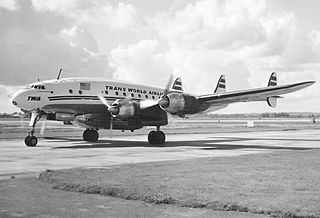
The Lockheed L-749 Constellation is the first Lockheed Constellation to regularly cross the Atlantic Ocean non-stop. Although similar in appearance to the L-649 before it, the L-749 had a larger fuel capacity, strengthened landing gear, and eventually weather radar.

The Allison T56 turboprop engine has been developed extensively throughout its production run, the many variants are described by the manufacturer as belonging to four main series groups.



















